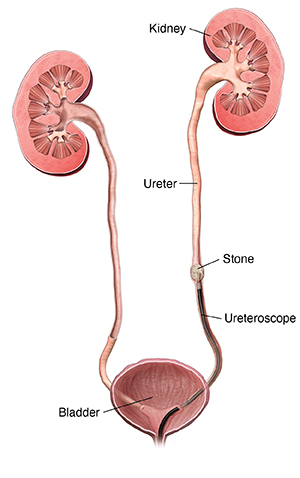Ureteroscopic stone removal may be done before, after, or instead of other treatments. If you need this procedure, your doctor will discuss its risks and possible complications. Talk with your doctor about your medical conditions, allergies, and any medicines you take. This includes medicines that don't need a prescription, vitamins, and supplements. You will get instructions on how to prepare. You will also be given information about the type of anesthesia you will have. This will keep you pain-free during treatment.
Removing the stone through the ureter
Ureteroscopic stone removal extracts a small stone in your ureter. This is done without an incision. The ureter is the tube that urine flows through from the kidney to the bladder. Your doctor places a viewing tube (ureteroscope) in your ureter. A wire basket inserted through the tube removes the stone. Sometimes, a laser or a mechanical device is used to break up a larger stone. A soft tube may be left in your ureter briefly to drain urine.
Your recovery
This is an outpatient or overnight procedure. For a few days after surgery, you may feel some pain when you urinate. You may also feel the need to urinate more often or have bloody urine.
You may be given medicines to relieve pain. You may also use ice packs or heating pads to relieve pain.
You may be given an antibiotic for 1 or 2 days to prevent an infection. If your doctor prescribed antibiotics, take them as directed. You need to take the full course of antibiotics.
You may be instructed to drink at least 8 to 16 ounces of water per hour for a few hours after the procedure.
You may have a ureteral stent. This is a soft tube that prevents swelling and blockage after the procedure. The stent is removed when the swelling goes down, often within days. Follow up as instructed to check for any new stones.
When to contact your doctor
Contact your doctor right away if:
-
You have sudden pain or flank pain.
-
You have a fever over 100.4°F (38°C), or as advised by your doctor.
-
You have nausea that lasts longer than suggested in your discharge instructions.
-
You have heavy bleeding when you urinate.
-
You have heavy bleeding through your drainage tube.
-
You have swelling or redness around your incision.


